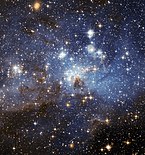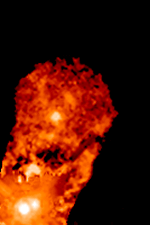T Tauri star
This article needs additional citations for verification. (January 2017) |

| Star formation |
|---|
 |
| Object classes |
| Theoretical concepts |
T Tauri stars (TTS) are a class of
History
While T Tauri itself was discovered in 1852, the T Tauri class of stars were initially defined by Alfred Harrison Joy in 1945.[3]
Characteristics
T Tauri stars comprise the youngest visible F, G, K and M
There is evidence of large areas of starspot coverage, and they have intense and variable X-ray and radio emissions (approximately 1000 times that of the Sun). Many have extremely powerful stellar winds; some eject gas in high-velocity bipolar jets. Another source of brightness variability are clumps (protoplanets and planetesimals) in the disk surrounding T Tauri stars.

Their spectra show a higher
The p-p chain for lithium burning is as follows
It will not occur in stars with less than sixty times the mass of Jupiter (MJ). The rate of lithium depletion can be used to calculate the age of the star.
Types
Several types of TTSs exist:[4]
- Classical T Tauri star (CTTS)
- Weak-line T Tauri star (WTTS)
- Naked T Tauri star (NTTS), which is a subset of WTTS.
Roughly half of T Tauri stars have
Analogs of T Tauri stars in the higher mass range (2–8
Planets
Planets around T Tauri stars include:
- HD 106906 b around an F-type star
- 1RXS J160929.1−210524b around a K-type star
- M-typestar
- M-typestar
- PDS 70b around a K-type star
See also
- Orion variable
- EX Lupi
- P Cygni profile
References
- S2CID 118324477.
- ^ "Stellar Evolution - Cycles of Formation and Destruction; Young Stellar Objects". chandra.harvard.edu. Retrieved 2023-01-31.
- doi:10.1086/144749.
- ^ Scott J. Wolk (1996). "T Tauri Stars, Naked and Otherwise". Retrieved 2018-03-14.
- Discussion of V471 Tauri observations and general T-Tauri properties, Frederick M. Walter, Stony Brook University, April 2004
- An empirical criterion to classify T Tauri stars and substellar analogs using low-resolution optical spectroscopy, David Barrado y Navascues, 2003
